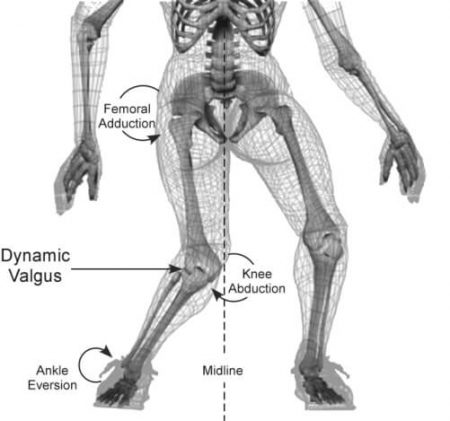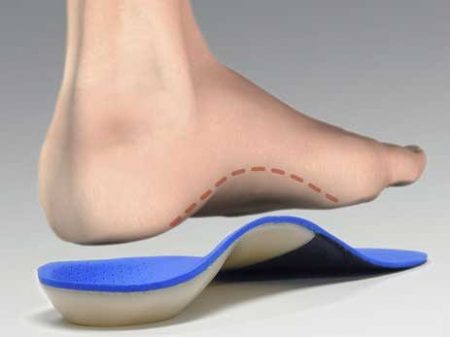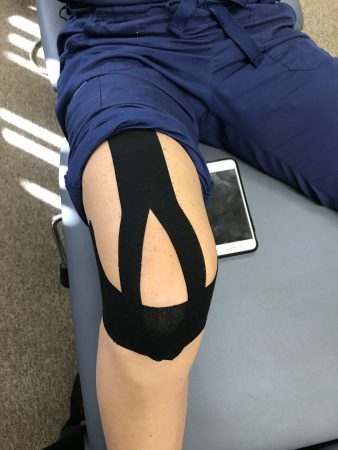What is it? Runners Knee or Patella Femoral pain Syndrome (PFPS) is a common diagnosis given to runners suffering from pain in the front of their knee that is sharp and stabbing when they run. It generally begins later in a run and quickly progresses to the point that it prevents running at all. Squatting, lunging and stairs are also often reported to be painful. If questioned patients will often report that their knee gets stiff and painful if they sit with their knee bent after running.
How did I get it?
There are many anatomical factors that contribute to development of Runners Knee or PFPS. Bowed legs, excessive internal rotation of the lower leg, pelvic muscle imbalances, leg length differences and overpronation are some of the most common. Overpronation causes excessive internal rotation of the lower leg causing excessive, repetitive strain on the outside of the knee and is one the most common reasons for development of the condition. The pelvic Q-angle or quadriceps angle is also a common contributing factor. A large Q-angle indicates a large hip to knee ratio (wide hips) resulting in a “knock-knee” appearance and overpronation while running. This anatomy type is prevalent in female runners.

if it is connected it is related
How is it treated?
There are many ways that Runners Knee or PFPS can be treated. What is important is that the right treatment is provided for the right cause.
Custom Orthotics: A proper foot orthotic can go a long way in taking the stress off of your knee. The right custom-made, biomechanical orthotic can address the underlying cause of your knee pain. Abnormal joint position, overpronation, foot rigidity or excessive Q-angle can be addressed and the biomechanics normalized. San Diego Running Institute orthotics are custom molded to your foot and designed with your specific body weight and activity in mind. The restoration of correct mechanical function takes the abnormal stress off the knee allowing it to heal.
Stretching/Strengthening: Often we are often told by runners that they have been stretching in an attempt to relieve pain associated with Runners Knee or PFPS. The stretching exercise is directed at lengthening the quadriceps tendon. The problem is that Runners Knee or PFPS is not a “stretching deficiency”. Strengthening of certain muscles may be effective but it is important to remember, it takes 4-6 weeks before muscles begin to strengthen in response to training. In addition anyone who has worked out in a gym can tell you that if you stop strengthening muscles they begin to shrink, lose strength and atrophy within two weeks! So if weakness is the cause of your knee pain you will have to do strengthening exercises for the rest of your running life or the pain will return. Avoid gimmick exercises as well as they often have high risk of injury and are no more effective than traditional rehabilitation exercises.
No Practical PurposeRest: For many runners rest is not a realistic option, the race you are training for is just around the corner. Our bodies are wonderful “machines”, if you rest it long enough it will heal itself. How long? This is uncertain. If you rest too long you may not be able to achieve your race goal. If you do not rest long enough the injury may not heal. There are some tools such as taping and bracing that might be effective in treating your Runners Knee.
Drugs/Anti-inflammatories: Drugs such as Ibuprofen are anti-inflammatory agents not healing agents. They actually impair the healing process and many times allow a runner to injure themselves further. Studies have shown that these medications are harmful to your body, can cause ulcers and strain your liver. In fact a recent study by the Human Performance Laboratory at the North Carolina Research Campus found ‘runner’s who popped over the counter ibuprofen pills before and during the race displayed SIGNIFICANTLY more inflammation afterward than the runners who hadn’t taken anti-inflammatories!
http://well.blogs.nytimes.com/2009/09/01/phys-ed-does-ibuprofen-help-or-hurt-during-exercise/
Ice: Ice is often recommended and is another example of a non-healing modality. A runner often reports that they have been icing their knee after running. Doing this may help with the pain and inflammation at the moment but how will it help to remove the abnormal stress that is occurring in your knee? How can it change your pronation? Your Q-angle? It won’t. What it will allow you to do is further injure your knee, resulting in permanent damage. Addressing the underlying biomechanical cause prevents further damage from occurring and allows you to complete your race injury free.
Steroid Injections: Steroid injections are painful and most doctors are reluctant to inject the knee. Since the steroid injection in no way corrects joint mechanics, overpronation or Q-angle they are generally not effective for this condition.
How long will it take to heal? This depends on how long you have been suffering from Runners Knee or PFPS. By correcting the cause of the injury with San Diego Running Institute orthotics and following the treatment regimen provided by Dr. Allen you can expect 50-100% relief usually within two to four weeks.







Leave A Comment